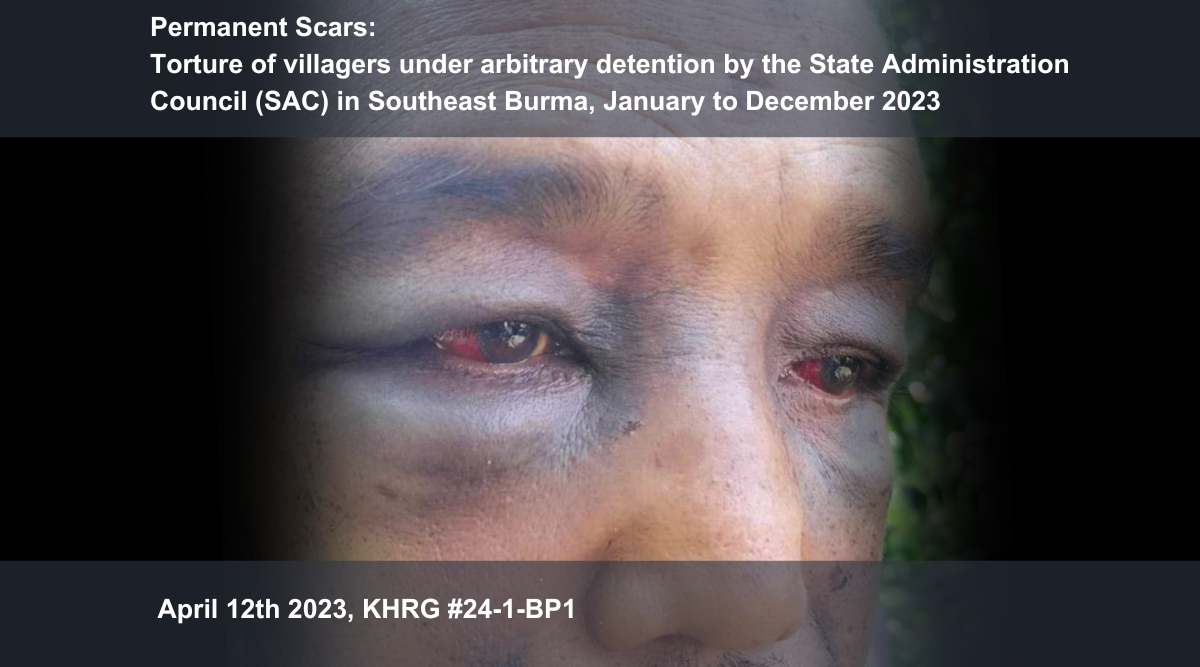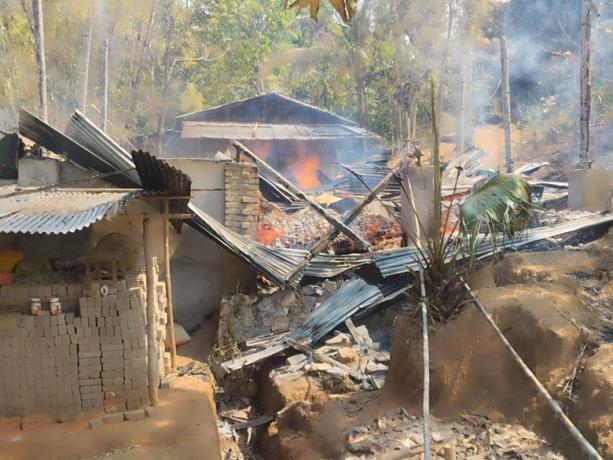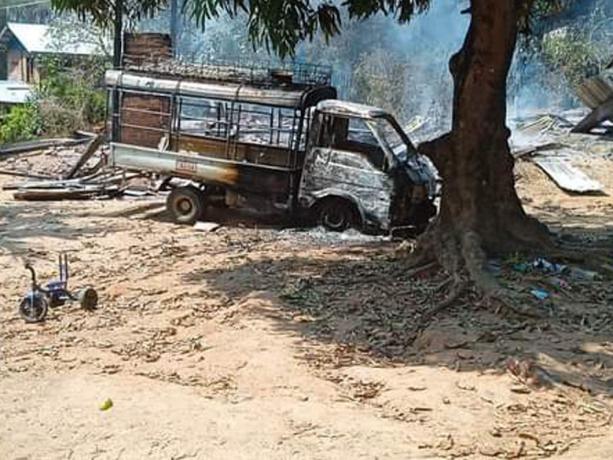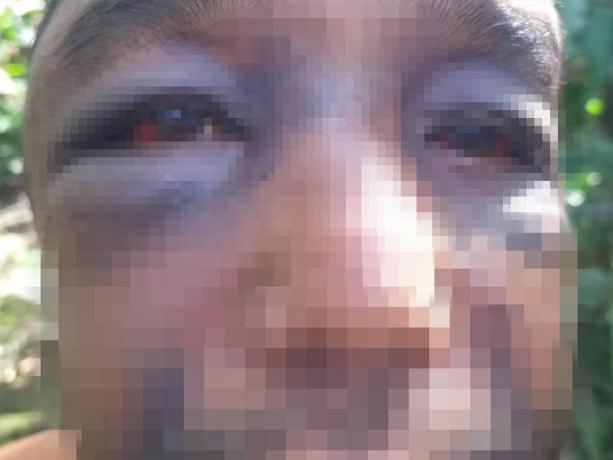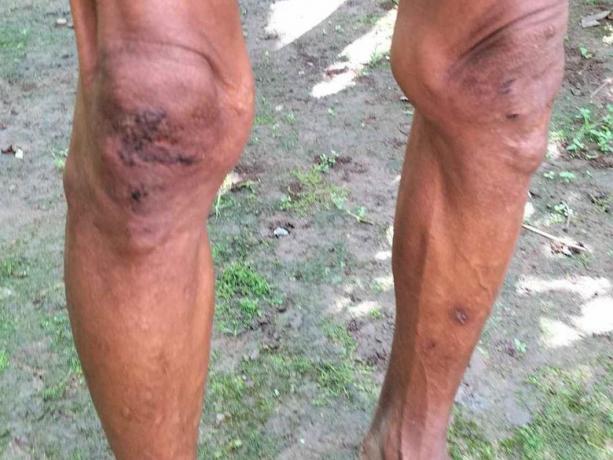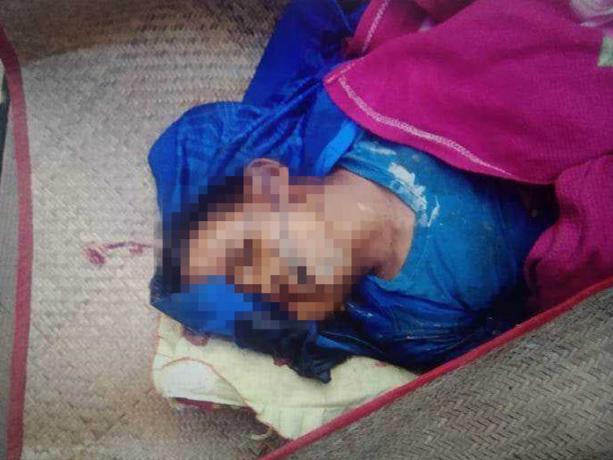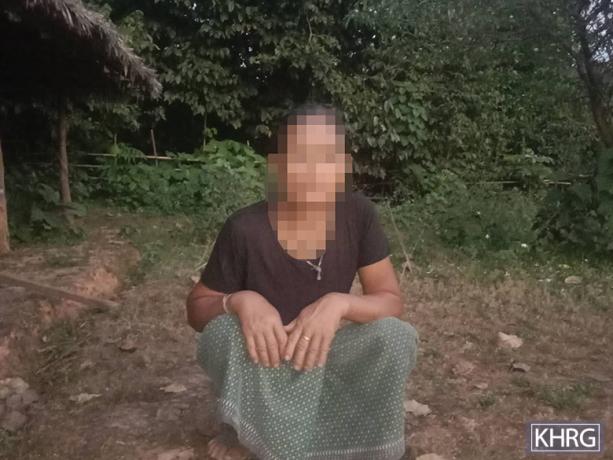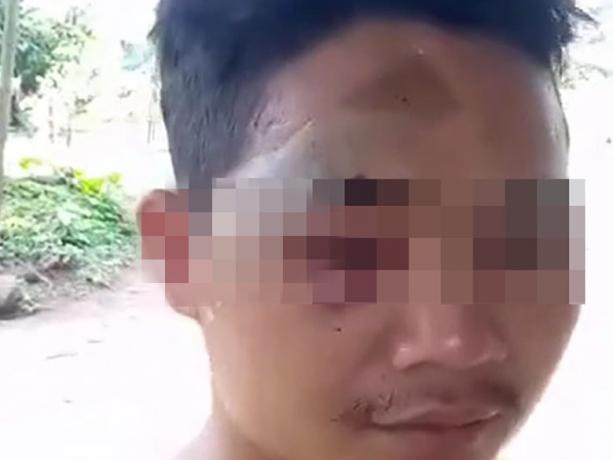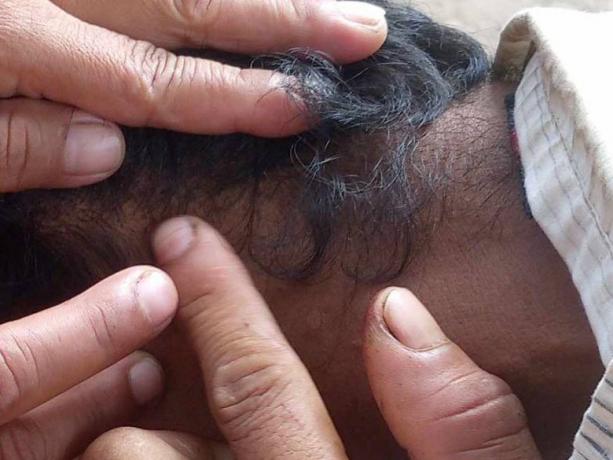1. Introduction
Since the 2021 military coup[1], human rights violations are being committed against villagers by armed actors in Southeast Burma[2] with increasing intensity. Among these violations, incidents of torture of civilians have seen an alarming increase: in 2023 alone, 33 incidents involving at least 37 victims were reported to KHRG, mainly perpetrated by the Burma Army.[3] This physical and mental violence is used by the State Administration Council (SAC)[4] as a weapon of war. Villagers in locally-defined Karen State[5] are particularly vulnerable to abuse, when continuously arbitrarily arrested and detained, as the SAC punishes and intimidates them in retaliatory violence, failing to adhere to international legal norms and the rules of war. This systematic abuse is impacting the security, livelihoods and freedom of movement of villagers, and causing severe injuries, fear and trauma.
This briefing paper presents incidents of torture against villagers in Southeast Burma by the SAC and affiliated armed groups in the period between January to December 2023.[6] The paper begins with a brief overview of the context in which torture has been occurring across Southeast Burma since the 2021 coup. It then presents a factual summary of the incidents of torture in 2023, and discusses the trends identified in the reports received by KHRG, including the torture of civilians arbitrarily arrested on accusations of affiliation with armed resistance groups or to extract information about their activities; to intimidate and terrorise the population; and/or when forcing villagers to act as human shields or porters. The impact of torture on the communities is also presented. Finally, a security and legal analysis of the situation of these severe human rights violations is conducted, and policy recommendations are provided for stakeholders.
2. Contextual Overview: torture as a weapon of war in Burma
For decades, villagers have been mistreated by the Burma Army who have sought to impose their political and military will over civilian populations across Burma. Civilians have long been targeted as part of the “four cuts” strategy, which aims to destroy links between insurgents, their families, and local villagers by severing supplies of food, funds, intelligence and recruits to armed resistance groups.[7] Amid the civil war, which has been intensifying in Karen State in the past three years, human rights abuses against civilians abound, including killings, air strikes on civilian areas, indiscriminate shelling, landmine usage, arbitrary arrests, enforced disappearances, widespread displacement, severe livelihood challenges, and barriers to education and healthcare.
The practice of arbitrary detention of civilians by the SAC is widespread in Burma, with approximately 20,240 political prisoners under detention across the country.[8] Under detention, civilians are highly vulnerable to abuse, mistreatment, or dire detention conditions, as the SAC fails to adhere to international law regarding the protection of prisoners and disallow the monitoring of conditions by lawyers or outside observers.[9] In rural Southeast Burma, villagers are frequently arrested and detained by SAC authorities in army camps, police stations, prisons, and checkpoints. In addition, villagers are often detained by soldiers in villages, on their plantations, or even their homes. Amid the ongoing conflict and the continued impunity enjoyed by armed actors, villagers are immensely vulnerable to extrajudicial killing, torture and mistreatment when detained in any of these circumstances and places.
The Burma Army has used torture for many decades, defined as the act of inflicting severe pain or suffering on someone to force them to do something or in punishment. Throughout the years, villagers have reported extreme torture including waterboarding, burning, cutting of body parts, hangings and burying underground, and torture has occurred both in detention facilities, in villages and forests, and sometimes publicly in charades of terror.[10] Some of these extreme methods are evident in the incidents documented in this briefing paper. Accusations of villagers being connected with armed resistance groups have been a common feature of torture in interrogation and punishment by the Burma Army throughout the many years of conflict. Ignoring international norms and regulations for the proper treatment of detainees, SAC soldiers inflict suffering on civilians under their captivity without recourse, to a degree which may amount to war crimes and crimes against humanity under customary international criminal law.
3. Factual summary: patterns of torture against villagers by the SAC and its impacts
This section presents evidence of the torture of villagers in Southeast Burma involving the SAC and SAC-affiliated groups. Since the 2021 coup, KHRG has received reports documenting 52 incidents of torture against villagers by the SAC military across our operational area.[11] In 2023 alone, KHRG received 36 reports detailing 33 of those incidents, and involving 37 victims of torture. Incidents of torture mostly occurred during arbitrary arrests; villagers were tortured as part of interrogation to extract information related to military objectives. Torture was also used against villagers in punishment for their alleged affiliation with opposition groups, either for being relatives, informants, or supporters of those groups, including suspicion of supplying them with food and materials. On other occasions, the SAC military tortured villagers in an abuse of power, to intimidate, terrorise and instil fear. Finally, villagers were also subjected to torture whilst being forced to act as human shields or porters by armed actors. Some instances of armed resistance groups operating in Southeast Burma torturing villagers have also been reported to KHRG, usually against those accused of being spies for the SAC, excluded from this analysis.[12]
a) Torture in interrogation to extract information
During the reporting period, the SAC military frequently arbitrarily arrested or detained villagers to obtain knowledge of local armed resistance groups’ activities. These arrests often occurred in the aftermath of attacks by resistance groups, as SAC soldiers sought to collect information on those involved. Torture was used to extract information or force confessions, and detention conditions were often dire. These interrogations also frequently happened publicly in villages, at checkpoints, on roads, or even in villagers’ houses. Many villagers who were arrested by the SAC were also forcibly disappeared, removed from protective measures or observation of their health or welfare by relatives or lawyers.[13] Villagers are at risk of being detained and subjected to intimidation and torture as they go about their daily lives, as the following incidents attest to.
On February 21st 2023, in search of People’s Defence Force (PDF)[14] members in the aftermath of fighting in the area, SAC soldiers from Light Infantry Battalion (LIB)[15] #603, led by Battalion Commander Hein San Htun, entered T’Hsee Theh Mee Lar Town, Than Tuang Way Thaw area, in Taw T’Htoo Township, Taw Oo District. The SAC soldiers arrested eight villagers who were taken to Than Taung police station, in Than Taung Town, where they were interrogated, beaten and punched. The SAC soldiers burned villagers’ houses and confiscated villagers’ belongings, including clothes and five motorcycles, which they burned altogether.
Later that day, five more villagers, three men and two women, from the same village were arrested by the SAC soldiers and questioned at the police station. All but one of the villagers were released shortly afterwards. As explained by a local person from T’Hsee Theh Mee Lar Town, a young villager was taken to an SAC army camp where he was interrogated and tortured before eventually being released a few days later. Villagers assumed that the SAC had found incriminating evidence related to other youngsters, possibly PDF members, on his phone.[16]
Villagers are arbitrarily arrested, and subsequently mistreated or tortured, in the aftermath of attacks against the SAC when soldiers search the area for those involved or who could have information on the attack. Travelling in the aftermath of attacks is therefore particularly dangerous for villagers. As explained by a victim of torture, that had taken place on January 6th 2023, in Dooplaya District: “They [the SAC] suspected me of being a spy. The fighting was happening when I returned to the village to feed my pigs. They suspected me of being a spy and arrested me. They asked many questions. They tortured me. I told them I was nothing [a civilian]. I told them I was a normal villager”. He added:
“I was afraid but could not do anything. I did not know how to be afraid. I considered myself dead.”
When the SAC interrogated him, he was kicked and stabbed by a knife several times.[17]
On another instance on March 26th 2023, at about 3 pm, Saw[18] A---, an 18-year-old villager, from Aa--- village, Aaw P’Lah village tract[19], Hsaw Htee Township, Kler Lwee Htoo District, was arrested by SAC Light Infantry Battalion (LIB) #20, who are based in Nyaunglebin Town, on suspicion of participating in a recent bomb attack along with six other villagers. Saw A--- was travelling by motorcycle to buy a duck to eat when he was arrested in Ba--- village. Saw A---’s mother, B---, was informed of her son’s arrest by other villagers living in Ba--- village. After hearing of the arrest, B--- and her husband went to find him: on March 27th at LIB #20 army camp and on March 28th, at Baw Bi police station. Saw A---’s parents had to provide the SAC soldiers with food and 20,000 kyat [9.50 USD[20]] for the cost of tea to be permitted to ask for information about their son. The SAC soldiers at Baw Bi police station told the victim’s parents not to worry about their son because he would be released soon after interrogation, if found not guilty. After he was released, Saw A--- explained to his mother about the brutal torture he had to endure: he was beaten in public relentlessly by the soldiers soon after his arrest before being taken to the police station, where he was again tortured during interrogation. Others from Ba--- village, who were also arrested along with Saw A---, reported that several villagers were also subjected to torture by the SAC.[21]
On another instance on September 18th 2023, after fighting and air strikes in T’Ko Teh village tract, Waw Ray Township, Dooplaya District, a 50-year-old villager named U[22] C---, from Ca--- village, K’Leh T’Khon Teh village tract, was arrested by the SAC soldiers when he returned from a displacement site to his village to feed his livestock. After the arrest, the SAC soldiers beat and punched him. Due to the severe injuries caused, he had to undergo medical treatment.[23]
Incidents of arrest and torture are also common at checkpoints. On November 16th 2023, a villager named Ko[24] D---, from Da--- village, Sa Htain village tract, Ler K’Saw Township, Mergui-Tavoy District, was apprehended by SAC soldiers from Infantry Battalion (IB)[25] #559 and #560 at a checkpoint on the road near Ea--- village. Ko D--- had visited Ea--- village to purchase items for himself, and was detained on the road while returning home. The soldiers stopped and searched him and his motorbike, and interrogated him. During the search of his motorcycle, the SAC soldiers discovered 20 tablets of yaba[26] hidden inside the seat. When questioned about these tablets, Ko D--- informed the SAC soldiers that they were for his personal use while working. However, one of the SAC soldiers said: “You are lying. I know you bought these drugs for the PDF”. During the interrogation, the SAC soldiers beat the villager. After, one of the SAC commanders threatened Ko D--- by saying: “You can’t tell anyone about this. If you do and we see this news on social media, we will kill you”. Since this incident, Ko D--- has been afraid to travel, and cannot eat well. Ko D---’s wife informed KHRG that villagers were living with fear and concern about their security.[27]
Many local villagers who have been impacted by the arrest and torture have been left with emotional distress and trauma. The escalation of arrests and torture in Southeast Burma has heightened villagers’ worry about being apprehended which is leading to fear of commuting to work or ensuring their livelihoods.
b) Torture and physical abuse as punishment
Villagers are arbitrarily arrested and detained often with no evidence provided for suspicion of affiliation with, or support to, local armed resistance groups; villagers are simply going about their daily lives. When detained on such accusations, SAC soldiers use intimidation, physical violence and other forms of mistreatment in punishment.
Saw E---, a young villager from Fa--- village, T’Nay village tract, Dwe Lo Township, Mu Traw District, was detained three times in November 2023 by the SAC, and at the end tortured to death. First, he was apprehended and detained at his farm, asked for his name and any military affiliation, and then forced along with some friends to guide SAC soldiers to Wa Wee Lay Road. The second time, he was arrested while travelling on a road with two friends, Maung[28] F--- and G---, and accused of having ties with Karen armed resistance groups after they were found carrying a battery with them, which villagers insisted was for personal use to charge their phones. The SAC soldiers gave these three young villagers 240,000 kyat [114 USD] and instructed them to purchase food for the soldiers in Ga--- village, T’Nay village tract. G--- was kept behind with the soldiers. Shortly afterwards, the soldiers were attacked by Karen National Liberation Army (KNLA)[29] soldiers. Maung F--- and Saw E--- were too afraid to return because of the fighting. The SAC soldiers thought the three young villagers were implicated in the attack, even accusing Maung F--- of being a KNLA officer. As punishment, G---, still detained by the SAC military, was severely tortured. The SAC soldiers burned his face with fire, stabbed a knife at his back, and beat his head. The soldiers told him: “You guys are Kaw Thoo Lei[30] soldiers [KNLA]. You see! When your friends were just released, they [KNLA] tried to attack us. […] If your friends do not come back and [KNLA] attack us [again], I will bury your body in a standing position.” The village head from Fa--- village negotiated with the SAC, who asked for the money they gave Maung F--- and Saw E--- in order to release G---. G--- was released the same day and needed treatment and medicine for his injuries.
On November 24th 2023, at around 3 pm, Saw E--- was arrested one more time by this same SAC troop beside a plantation while he was going to meet his friends. He was detained alongside Saw H---, a villager from Ga--- village, T’Nay village tract, who had been arrested earlier; the two men were tied up together. Soon after he was detained, the SAC sergeant in charge gave soldiers knives and took Saw E--- to be tortured. They beat and kicked him and then cut out his eyes and cut his ears with knives. The soldier told him: “Last time [that Saw E--- was arrested], you took the money and after you left, you attacked us. And now, you come and sneak up on us again.” As they took out his eyes and cut his ears, they told him: “The eyes that snuck up on us and the ears that were eavesdropping.” During the torture of Saw E---, H--- was able to slip away and escape. He informed villagers in T’Nay area about what happened to Saw E--- and Fa--- villagers went to look for him nearby Meh Pray Hkee army camp. The SAC soldiers there told villagers that Saw E--- might had been killed during an attack by the KNLA and gave no more information.[31]
Saw H--- had been arrested on November 22nd 2023 while he was herding his cows in Ga--- area. The SAC asked him questions and also accused him of having connections with the KNLA soldiers. Saw H--- recalled:
“They [SAC soldiers] hit me with a machete and I was bleeding. They slapped me in the face. After that, they went to take a rope and tied me from the back. My hands were swelling, as the blood was not running [through]. It was so tight. I could not stand it anymore, so I asked the SAC sergeant to loosen the rope. I was a bit more comfortable when the rope was loosened.”
He was tied up together with Saw E--- on that night, after two days of arrest. When SAC soldiers questioned and tortured Saw E---, Saw H--- untied the rope by scrubbing it and escaped into the forest. After his escape, he was not able to sleep for several days due to fear. Since then, villagers are afraid of being arrested by the SAC soldiers so they dare not going to their farmlands or hill fields to secure their livelihood.[32]
On another instance, on the morning of July 9th 2023, villagers residing near the eastern part of the Pa Ra Lo river in Ler Doh Township, Kler Lwee Htoo District, went to Kyauk Ta Ga Town to purchase food. SAC soldiers from LIB #264 detained them when they entered the town and apprehended 16 of the villagers, accusing them of transporting rice and other items to the PDF. Among the arrested villagers, three individuals were severely beaten by SAC soldiers, as reported by their family members. Despite being able to provide food for the detainees, the families were denied access to see them. During a subsequent meeting with village leaders on July 14th 2023, the family members expressed their desire to secure the release of the villagers but were too afraid to directly confront the SAC soldiers. In August 2023, these arrested villagers were released and many fled their villages, facing security concerns.[33]
On September 11th 2023 from 5 to 6 am, there was a fighting between PDF troops and SAC, involving over 30 soldiers from the Infantry Battalion (IB) #285 marching to Ja--- village, Pu Law area, Ler Muh Lah Township, Mergui-Tavoy District. After the fighting, the SAC indiscriminately conducted constant shelling into nearby villages and vicinities, up until 12:30 pm. This shelling resulted in the displacement of villagers. While fleeing, a 26-year-old villager named Maung K---from Ja--- village, Pu Law area, Ler Muh Lah Township, was arrested by the SAC. The soldiers tortured Maung K--- to death. They also arrested other villagers and brought them to Pu Law Town’s police station. Some villagers were released after a while.[34]
If a villager is arrested on suspicion of affiliation with an armed resistance group, it is common that their family members and close associates will also be targeted, in punishment. This creates much fear among villagers if a friend or family member is detained, regardless of any truth to the claims. In one incident in which a human rights defender was arrested, falsely accused of being PDF, and forcibly disappeared, his daughter feared being targeted herself: “After they arrested my father, I heard that SAC tried to look for the family members. They showed our pictures to people, and they asked people where we were. They also asked people about how many children my father has. They asked people whether we came back to Rb--- [the family’s hometown] or not. […] I think they wanted to arrest all my father’s family members because they wanted to make sure they could arrest every family member of my father. […] We have security concerns. We have to flee from place to place.”[35]
c) Torture as intimidation or as an abuse of power
Torture of villagers is also committed by the SAC and other affiliated armed groups with no clear military objectives discernible. These incidents can be seen as efforts to demonstrate that SAC soldiers have the power to act without fear of punishment from any legal mechanism. They can act with impunity, terrorise and intimidate villagers, and inflict pain on the civilian population, in a grave abuse of power.
For instance, in April 2023, Saw L---, a 30-year-old resident of Ka--- village in the K’Moh Thway area, Ler Doh Soh Township, Mergui-Tavoy District, was apprehended by SAC LIB #409, stationed at the Nga Pyaw Daw Wa checkpoint in Da Wei Town. Saw L--- was returning home by motorbike from escorting students to school in Da Wei Town. The SAC soldiers stationed at the checkpoint were intoxicated and called out to him, but he could not hear them due to the noise of a car engine and hence did not stop. Then, the SAC soldiers followed him by car and apprehended him in La--- village, located in the Htee Ler Klay area. Following his arrest, the SAC soldiers physically assaulted him using sticks. Saw L--- is an ordinary villager who earns a living by working on his hill field.[36]
In another incident, on August 17th 2023, Saw Ta Dah Win, an officer of the Democratic Karen Buddhist Army (DKBA)[37] -affiliated with the SAC- tortured three villagers on a road located in Mee Kyain village tract, Hpa-an Township, Doo Tha Htoo District. The villagers were Saw M--- (49 years old), Saw N--- (23 years old) and Saw O--- (40 years old), from Na--- village, Mee Kyain village tract. These villagers work as daily labourers, selling gravel to support their livelihood. When the DKBA officer noticed a gravel pile obstructing the road during his travel to Ma--- place in Hpa-an Township, he confronted the villagers. Despite the villagers’ apologies and willingness to remove the gravel, the DKBA officer violently assaulted them. Saw M--- suffered a split lip from a wooden stick blow, and Saw N--- and Saw O--- were also repeatedly struck. This incident has left local villagers living in fear of similar mistreatment. The perpetrator, Saw Ta Dah Win, serves as an operation commander in a DKBA battalion led by Saw Bo Bee.[38]
SAC soldiers also apprehended villagers whilst they were undertaking their livelihood activities in fields and plantations. For example, on October 7th 2023 at 4:30 pm, SAC soldiers arrested and assaulted Naw[39] P---, from Oa--- village, Ma Htaw village tract, Dwe Lo Township, Mu Traw District. She was arrested by the SAC soldiers at her farmland located in Thwah Hkoh Law area, while she was herding buffaloes. Naw P--- was taking care of her three buffaloes because she thought it was a higher risk for her sons and son-in-law to do the herding work during this time of intensified conflict. When apprehended by SAC soldiers, they asked her random questions trying to obtain information about any armed resistance activities in the area, pointing a gun at her chest. Naw P--- was then taken to see the SAC commander at the SAC base in a forest at Wa May Kyoh place. Naw P--- does not speak Burmese, so it was challenging to communicate with the SAC soldiers, but she managed to convey that she was alone and had simply been herding buffaloes. Despite this explanation, however, she was still mistreated, tied up the entire night in the forest, leaving her wet, cold, and deprived of food. Later, the SAC soldiers offered snacks, which she hesitantly accepted, fearing potential harm. On the next day, at dawn, she was released.[40]
As has been demonstrated, villagers in Southeast Burma often face arrest and torture alongside other human rights violations by the SAC and affiliated armed groups whilst they are travelling, purchasing goods, or working. For villagers who must travel for their livelihoods, or to carry out other daily tasks, avoiding interactions with armed actors is impossible, especially since some events occur unexpectedly and there are many checkpoints on roads. Saw Q---, a 26-year-old villager from Pa--- village, A’Lu village tract, Kyeh Htoh Township, Doo Tha Htoo District, whose father was arrested whilst travelling for his livelihood as a day labourer, expressed his fears:
“Before the coup, we could travel freely. We did not hear about arbitrary arrests. After the coup, we are afraid to go to A’Lu Lay. We are afraid when we are travelling. We are concerned about the fighting that is going to happen. Before the coup, our livelihood activities were fine. Yet, after the coup, our livelihood is restricted”.[41]
d) Torture of villagers forced to act as human shields and porters
The SAC arbitrarily arrests villagers to force them to act as human shields or forced porters, accompanying troops as they travel on foot through contested territory. These acts may indeed be seen as torture in themselves, such as the hard physical labour of being forced to carry heavy loads whilst at risk of being attacked by armed groups whilst travelling. Moreover, villagers being forced to act as human shields are often mistreated and physically abused whilst under detention. They are also forcibly disappeared, isolated and cut off from communication with others. In 2023 alone, KHRG documented 13 incidents of use of human shields and forced portering, involving at least 97 villagers.[42]
In one reported incident, on March 20th 2023, 50 to 70 soldiers from SAC Light Infantry Division (LID)[43] #77 and other combined troops, entered Qa--- village and Ra--- village, Nah Tha Kway village tract, Moo Township, Kler Lwee Htoo District. The soldiers arrested 22 villagers in total, including four children aged between 6 to 17. The SAC released six villagers (including two people with disabilities) and took the rest with them as human shields. These arrested villagers were tied up and were forced to walk in front of the SAC soldiers and threatened that they would be killed if KNLA soldiers were to attack on the way. The next day, two elderly villagers were released but 14 villagers remained detained including the three children. One villager taken as a human shield in this incident, Saw R---, explained:
“After arresting us, they tied up our hands; 7-8 people in a set. They did not tell us where they were going to take us. They were so aggressive communicating with us so we dare not refuse to follow them once they arrested us. The soldiers said: ‘Don’t you dare to escape! If you do so, we will shoot you dead.’ How would we dare to escape when they are that aggressive? We dared not even move”.
The SAC soldiers confined these arrested villagers in a classroom of Ra--- village school, locking the door. For five days, these villagers endured living, eating, sleeping, and using a trash bin as a makeshift toilet in the cramped room. Once a day, the SAC soldiers would open the door, allowing the detainees to clean their hands and legs, and bathe. The SAC soldiers hung their clothes in front of the classroom where the villagers were detained so it would be targeted if attacked by KNLA soldiers. On March 24th 2023, the SAC released all of the villagers by tying them up in the forest.[44]
On July 9th 2023, SAC LIB #559 and #560, led by Commander Min Min Htun and based in the army camp in Ea--- village, Sa Htain village tract, Ler K’Saw Township, Mergui-Tavoy District, travelled to Da--- village. On their way, at around 9 am, they arrested Ko S---, a villager from Da--- village, and forced him to carry their ammunition. Ko S--- explained that he suffered from lower back pain and could not carry the bullets. Then, one of the SAC soldiers named Ko San Naing, told him: “Don’t talk nonsense. You have to carry bullets as we ask you to do so”, and continued to force him to carry their bullets. As they travelled, the SAC soldiers arrested whoever they saw on their way and took them as porters and human shields. Ko S--- reported to KHRG that the SAC arrested ten villagers in total, forcing them to carry their ammunition and walk in front of the soldiers. Among the arrested villagers were a three-year-old child and his mother. When they arrived at a plantation, owned by Ko T--- (a villager from Da--- village), they encountered Kaw Thoo Lei Army (KTLA)[45] soldiers and fighting happened. The KTLA soldiers realised that there were also villagers with the SAC soldiers and so stopped firing guns and retreated. During the fighting, the SAC soldiers told the arrested villagers to crouch down but did not let them put down the ammunition they carried. None of the villagers were injured or hit by bullets during the fighting, nor were any of the soldiers. After the fighting, the SAC told the villagers: “You did a good job”, and released them all, leaving them to walk two hours home. Ko S--- stated: “They [SAC] would not have released us if any of their soldiers had died or had been injured.” Ko S--- and the other arrested villagers still feel afraid and panicked after being released: they worry and fear that they will be arrested again and killed.[46]
Villagers who were released or who managed to escape captivity suffer afterwards from the trauma and face recovery from injuries sustained during the torture. After being taken as human shields by the SAC in March 2023, Qa--- and Ra--- villagers, Nah Tha Kway village tract, Moo Township, expressed they were experiencing significant emotional distress. One of the victims from Ra--- village explained:
“Because of this arrest, we were afraid, and one of the children got sick [with shock]; it seems that this child was very afraid. Some elders also had to take medicine after returning to the village.”
The experience of being forced to act as a human shield is traumatic and this is compounded by the high frequency of these crimes: villagers know they may be targeted again. Some villagers who have been tortured and released need continued treatment due to their injuries. With the intensification of armed conflicts and difficulty working to get income, families are struggling to support the injured victims.
4. Analysis: Legal implications of the torture of villagers by the SAC
Villagers in Southeast Burma are individually targeted, assaulted and tortured by SAC soldiers in order to extract information about armed resistance groups, punished for alleged affiliation with such groups, intimidated and terrorised, or dehumanised when captured as human shields or forced porters. Following attacks by armed resistance groups, villagers have been common targets of retaliatory violence, as the SAC violently seeks to extract information and locate resistance soldiers in and around villages. Civilians face constant insecurity, frequently attacked while in their villages, on their plantations or farms, or on roads when travelling for essential livelihood activities. Any potential contact with SAC soldiers puts villagers at risk of ill-treatment. SAC soldiers fail to respect the basic rights, dignity and integrity of civilians, treating them as enemies and legitimate targets.
Endemic across the whole of Burma and escalating with increasing fervour, the incidents presented in this report are an aspect of the widespread and systematic arbitrary detention of civilians by the SAC, who often entangle the lines between civilians, political enemies and military targets. Under detention, whether held temporarily at checkpoints or confined in prisons, villagers are at grave risk of ill-treatment and torture. Even detention in one’s home can involve beatings, intimidation, and other torturous violence. The scale of the abuse of power by the SAC against civilians demonstrates their confidence in their own impunity.
Torture is defined under international law as any act by which severe pain or suffering, whether physical or mental, is intentionally inflicted on a person to obtain information from them or a third party, to punish for an act committed, or suspected of having committed, to intimidate, coerce, or for any reason based on discrimination.[47] The protection against torture and inhuman or degrading treatment is an absolute human right which upholds the individual’s right to the protection of his or her dignity and integrity, enshrined in Article 5 of the 1948 Universal Declaration of Human Rights (UDHR).[48] In the incidents detailed in this briefing paper, the SAC tortured villagers to extract information about local armed resistance attacks or activities, and punish villagers accused of being affiliated with or supporting local PDFs. Other incidents also included in this briefing paper as evidence encompass violence and ill-treatment at the hands of the Burma Army.
Under international human rights law, these incidents evidence many violations of the 1948 UDHR,[49] including violations of villagers’ right to life, liberty and security, freedom from torture and other cruel, inhuman and degrading treatment or punishment, freedom from arbitrary arrest or detention, and freedom of movement.[50] The prohibition is further recalled by other universal and regional conventions.[51]
Even though Burma is not a signatory to the 1984 Convention Against Torture and Other Cruel, Inhuman and Degrading Treatment or Punishment, as one of the most universally recognised human rights, the prohibition of torture has acquired status of customary international law, thus creating an obligation erga omnes, owed to and by all states, to act against those who torture, even if a state has not ratified the relevant treaty.[52] Moreover, under international humanitarian law (IHL), the targeting of civilians violates the fundamental principle of distinction between civilian and military targets in the conduct of hostilities, as enshrined in Common Article 3 of the 1949 Geneva Conventions, Articles 27 and 32 of the Fourth Geneva Convention Relative to the Protection of Civilians, and reaffirmed in Rule 1 of the ICRC Commentary of Customary IHL.[53] Any violation of these rights is qualified as a grave breach, allowing universal jurisdiction to bring the perpetrators to justice.[54] As further stated by Rule 90 of the ICRC Commentary, torture is prohibited in non-international armed conflicts, such as that occurring in Southeast Burma.[55] Moreover, Rule 156 of the ICRC Commentary qualifies torture as conduct that endangers protected persons and violates important values, such as by subjecting persons to humiliating treatment or forcing persons to undertake work that directly helps military operations of the enemy, as constituting war crimes.[56]
Under international criminal law, exemplified by Article 8(2)(c)(i) of the Rome Statute of the International Criminal Court,[57] torture as a war crime in a non-international armed conflict needs to meet the requirement of the 1984 Convention Against Torture: i) the instrumental purpose of the criminal act, and ii) the act of torture must be committed by, or with the involvement, of a person in a position of authority (public official, de facto organ of a state, or other non-private capacity).[58] The SAC’s acts of torture against civilians for their alleged participation in or support of armed resistance groups meet the requirements to be qualified as war crimes. Torture may also constitute a crime against humanity under Article 7(1)(f) and, residually, (k) of the Rome Statute, when is committed as part of a widespread and systematic attack on a civilian population.[59] Notably, torture as a crime against humanity does not require an instrumental purpose, as the degree of aggression upon personal dignity and integrity is sufficient to make it a matter of international concern. Some of the incidents which occurred in the context of detention by the SAC may not have involved this purposive intent, but given their frequency and systematic nature, they may nevertheless amount to crimes against humanity.
5. Recommendations
For international stakeholders, non-governmental organisations (NGOs), and regional and foreign governments:
- Acknowledge the serious crimes committed by the Burma Army leaders and avoid endorsing or legitimising the State Administration Council (SAC). This includes refraining from entering into agreements with them, granting them official recognition, and inviting them to participate in international forums and functions.
- Support local civil society and community-based organisations (CSO/CBOs) and ethnic service providers that prioritise human rights, and work with them to strengthen support systems for victims.
- Support local CSOs/CBOs to expand psychological support programmes -in all ethnic regions and languages- for survivors, their families, and the communities to help them cope with trauma, uncertainty and fear.
- Listen to and support local and civil society organisations in their efforts to document arbitrary detention and torture in Southeast Burma, advocate for victims’ rights, and provide comprehensive support to ensure the safety and protection of witnesses who come forward to testify about arbitrary arrest, detention, and torture. This support should include relocation, psychosocial support, legal aid, and financial assistance.
- Support efforts to hold the Burma Army leaders accountable for their vast array of crimes in impartial and independent courts, including the International Criminal Court (ICC), International Court of Justice (ICJ), and foreign national courts with universal jurisdiction.
- Broaden the scope of international investigations to include torture and arbitrary detention faced by civilians residing in Southeast Burma.
- Raise international awareness of the crimes of torture and arbitrary detention in rural Southeast Burma and explore actionable measures to deter and address the occurrence of these crimes.
Footnotes:
[1] On February 1st 2021, the Burma (Myanmar) military deposed the democratically elected government led by the National League for Democracy (NLD). The military transferred power to Min Aung Hlaing, the Commander-in-Chief of Burma’s Armed Forces. Based on unproven fraud allegations, the Burma military invalidated the landslide victory of the NLD in the November 2020 General Election and stated it would hold new elections at the end of the state of emergency. Elected President Win Myint and State Counsellor Aung San Suu Kyi were detained, along with ministers, their deputies and members of Parliament.
[2] In 1989, the then-ruling military regime changed the name of the country from Burma to Myanmar without consultation from the people. KHRG prefers the use of Burma because it is more typically used by villagers, and since the name change to Myanmar is reflective of the military regime’s longstanding abuse of power.
[3] The terms Burma military, Burma Army, and SAC are used interchangeably throughout this report to describe Burma’s armed forces. Villagers themselves commonly use Burma Army, Burmese soldiers, or alternatively the name adopted by the Burma military regime at the time -since the 2021 coup, the State Administration Council (SAC).
[4] The State Administration Council (SAC) is the executive governing body created in the aftermath of the February 1st 2021 military coup. It was established by Senior General Min Aung Hlaing on February 2nd 2021, and is composed of eight military officers and eight civilians. The chairperson serves as the de facto head of government of Burma (Myanmar) and leads the Military Cabinet of Burma, the executive branch of the government.
[5] Karen State, defined locally, includes the following areas: Kayin State, Tanintharyi Region and parts of Mon State and Bago Region. Karen State, located in Southeastern Burma, is primarily inhabited by ethnic Karen people. Most of the Karen population resides in the largely rural areas of Southeast Burma, living alongside other ethnic groups, including Bamar, Shan, Mon and Pa’Oh.
[6] The present document is based on information received from February 2023 to February 2024. It was provided by community members in six out of seven districts of Karen State who have been trained by KHRG to monitor human rights conditions on the ground. The names of the victims, their photos and the exact locations are censored for security reasons. The code names do not correspond to the actual names or to coding used by KHRG in previous reports.
[7] KHRG, Undeniable: War crimes, crimes against humanity and 30 years of villagers’ testimonies in rural Southeast Burma, December 2022.
[8] Assistance Association for Political Prisoners (AAPP Burma), ‘Political Prisoners Post-Coup’ monitoring as of 15th March 2024, available at: aappb.org/
[9] AAPP (Burma), Political Prisoners Experience in Interrogation, Judiciary, and Incarceration Since Burma’s Illegitimate Military Coup, March 2022, pp. 6-11 available at: aappb.org/?p=20734
[10] KHRG, Undeniable, above, December 2022.
[11] KHRG operates in seven areas in Southeast Burma: Doo Tha Htoo (Thaton), Taw Oo (Toungoo), Kler Lwee Htoo (Nyaunglebin), Mergui-Tavoy, Mu Traw (Hpapun) and Dooplaya and Hpa-an. When KHRG receives information from the field, it organises data according to these seven areas. These are commonly referred to as ‘districts’ and are used by the Karen National Union (KNU), as well as many local Karen organisations, both those affiliated and unaffiliated with the KNU. KHRG’s use of the district designations in reference to our research areas does not imply political affiliation; rather, it is rooted in the fact that many rural communities commonly use these designations. For clarity, the Burmese terms for these districts are provided in brackets but do not correspond with the Burma (Myanmar) government administrative divisions.
[12] For torture incidents committed by the People’s Defence Force (PDF) and Kawthoolei Army (KTLA), for instance, see: KHRG, In the Dark: The crime of enforced disappearance and its impact on the rural communities of Southeast Burma since the 2021 coup, November 2023, pp.32-33.
[13] KHRG, In the Dark, above, November 2023.
[14] The People’s Defence Force (PDF) is an armed resistance established independently as local civilian militias operating across the country. Following the February 1st 2021 military coup and the ongoing brutal violence enacted by the junta, the majority of these groups began working with the National Unity Government (NUG), a body claiming to be the legitimate government of Burma/Myanmar, which then formalised the PDF on May 5th 2021 as a precursor to a federal army.
[15] A Light Infantry Battalion (LIB) comprises 500 soldiers. Most Light Infantry Battalions in the Tatmadaw (or Burma Army) are under-strength with less than 200 soldiers, yet up-to-date information regarding the size of battalions is hard to come by, particularly following the signing of the National Ceasefire Agreement (NCA). LIBs are primarily used for offensive operations, but they are sometimes used for garrison duties.
[16] Unpublished report from Taw Oo District, received in March 2023.
[17] KHRG, In the Dark, above, p. 20
[18] ‘Saw’ is a male honorific title in S’Gaw Karen language used before a person’s name.
[19] A village tract is an administrative unit of between five and 20 villages in a local area, often centred on a large village.
[20] All conversion estimates for the kyat are based on the 18th March 2024 mid-market exchange rate of 1,000 kyat to USD 0.48 (taken from https://wise.com/gb/currency-converter/mmk-to-usd-rate).
[21] Unpublished report from Kler Lwee Htoo District, received in August 2023.
[22] ‘U is a Burmese male honorific title used before a person’s name.
[23] Unpublished report from Dooplaya District, received in September 2023.
[24] ‘Ko’ is a Burmese title meaning older brother. It can be used for relatives as well as non-relatives.
[25] An Infantry Battalion (IB) comprises 500 soldiers. However, most Infantry Battalions in the Tatmadaw are under-strength with less than 200 soldiers. Yet up to date information regarding the size of battalions is hard to come by, particularly following the signing of the NCA. They are primarily used for garrison duty but are sometimes used in offensive operations.
[26] Yaba, which means ‘crazy medicine’ in Thai, is a tablet form of methamphetamine. Introduced to East Asia during World War II to enhance soldiers’ performance, methamphetamine has become increasingly popular in Thailand, Laos, Cambodia Vietnam, and in Burma where it is typically manufactured; see “Yaba, the ‘crazy medicine’ of East Asia” UNODC, May 2008 and KHRG, “Chapter: Drug production, use and the social impacts in Southeast Myanmar since the January 2012 ceasefire,” in Truce or Transition: Trends in human rights abuse and local response in Southeast Myanmar since the 2012 ceasefire, June 2014.
[27] Unpublished report from Mergui-Tavoy District, received in November 2023.
[28] ‘Maung’ is a Burmese male honorific title used before a person’s name.
[29] The Karen National Liberation Army (KNLA) is the armed wing of the Karen National Union (KNU).
[30] The term Kawthoolei (or Kaw Thoo Lei) refers to Karen State as demarcated by the Karen National Union (KNU), but the exact meaning and etymology is disputed; see: Jonathan Falla, True Love and Bartholomew: Rebels on the Burmese Border, Cambridge University Press: 1991.
[31] Unpublished report from Mu Traw District, received in January 2024.
[32] Unpublished report from Mu Traw District, received in January 2024.
[33] KHRG, In the Dark, above, p. 29.
[34] Unpublished report from Mergui-Tavoy District, received in September 2023.
[35] Unpublished report from Taw Oo District, received in April 2023.
[36] Unpublished report from Mergui-Tavoy District, received in June 2023
[37] In 1994, the Democratic Karen Buddhist Army (DKBA) split from the KNLA over religious considerations. In 2010, the majority of DKBA troops transformed into BGFs, but one faction refused and changed its name to Democratic Karen Benevolent Army in 2012. In 2015, the DKBA Splinter Group split from this faction and reclaimed their original name, Democratic Karen Buddhist Army. It is active in Mu Traw (Hpapun) and Hpa-an districts, and it has not signed the NCA.
[38] KHRG, “Doo Tha Htoo District Incident Report: A DKBA operation commander tortured three villagers in Hpa-an Township (August 2023)”, December 2023.
[39] ‘Naw’ is a female honorific title in S’Gaw Karen language used before a person’s name.
[40] Unpublished report from Mu Traw District, received in November 2023.
[41] Unpublished report from Doo Tha Htoo District, received in July 2023.
[42] Since February 2021, KHRG has received at least 22 reports containing evidence of SAC soldiers using human shields, involving more than 564 villagers. See: KHRG, Shadow of Death: Use of civilians as human shields by the State Administration Council (SAC) in Southeast Burma since the coup, July 2023.
[43] A Light Infantry Division (LID) of the Tatmadaw is commanded by a brigadier general, and consists of ten light infantry battalions specially trained in counter-insurgency, jungle warfare, search and destroy operations against ethnic insurgents . They were first incorporated into the Tatmadaw in 1966. LIDs are organised under three Tactical Operations Commands, commanded by a colonel, three battalions each and one reserve, one field artillery battalion, one armoured squadron and other support units. Each division is directly under the command of the Chief of Staff (Army).
[44] KHRG, “Kler Lwee Htoo District Incident Report: Villagers arrested as human shields, and shelling and looting by the SAC in Moo Township, March 2023, October 2023”.
[45] The Kaw Thoo Lei Army (KTLA) was founded on July 17th 2022 by Brigadier-General Nerdah Bo Mya. Nerdah Bo Mya, former Commander-In-Chief of the Karen National Defence Organisation (KNDO), was dismissed by the KNU in 2022. KTLA operates in two districts in Southeast Burma, in KNU-controlled areas, namely Mergui-Tavoy and Dooplaya districts. In Dooplaya District, they operate in alliance with resistance armed groups. KTLA battalions in Mergui-Tavoy District are in conflict with both SAC and KNLA troops.
[46] Unpublished report from Mergui-Tavoy District, received in July 2023.
[47] 1984 Convention Against Torture and Other Cruel, Inhuman and Degrading Treatment or Punishment, Article 1
[48] 1948 Universal Declaration of Human Rights (UDHR), Article 5.
[49] 1948 United Nations Declaration of Human Rights (UDHR)
[50] 1948 United Nations Declaration of Human Rights (UDHR), Article 3, Article 5, Article 9, Article 13.
[51] 1966 International Covenant on Civil and Political Rights (ICCPR), Article 7; and 2012 ASEAN Human Rights Declaration, Art 14
[52] 1984 Convention Against Torture and Other Cruel, Inhuman and Degrading Treatment or Punishment (‘Convention Against Torture’).
[53] The 1949 Geneva Conventions and their Additional Protocols, Common Article 3: ‘Conflicts not of an international character’; Convention (IV) relative to the Protection of Civilian Persons in Time of War. Geneva, 12 August 1949, Article 27 and Article 32; ICRC, Customary IHL Database Rule 1: The Principle of Distinction between Civilians and Combatants,
[54] 1949 Geneva Convention (IV), Article 146 and Article 147
[55] ICRC, Customary IHL Database Rule 90: Torture and Other Cruel, Inhuman or Degrading Treatment.
[56] ICRC, Customary IHL Database Rule 156: Definition of War Crimes.
[57] 1998 Rome Statute of the International Criminal Court, Article 7(2)(i).
[58] 1984 Convention Against Torture, Article 1
[59] 1998 Rome Statute, Article 7(1)(f) and (k)

